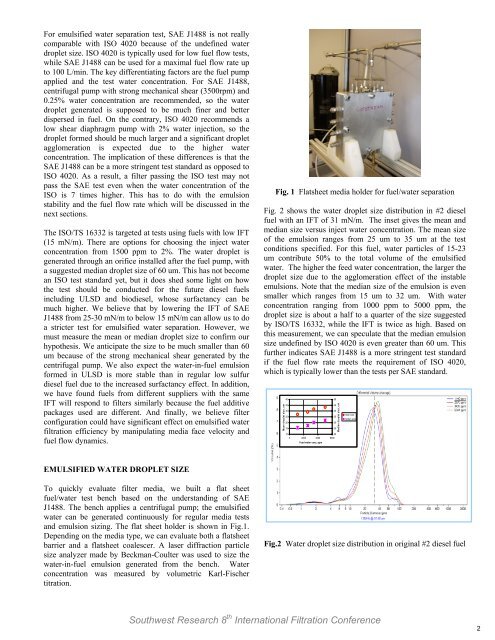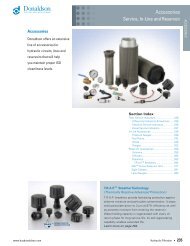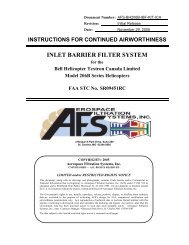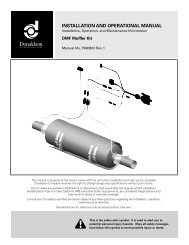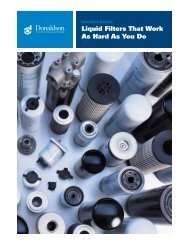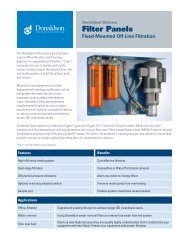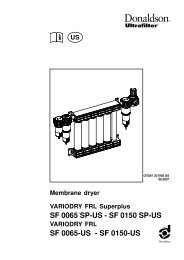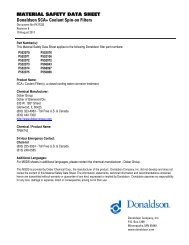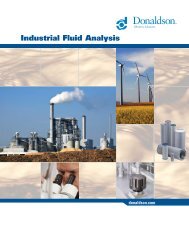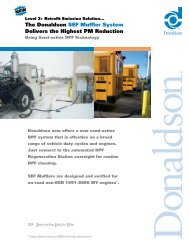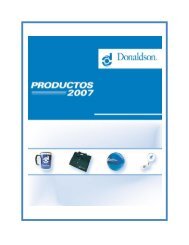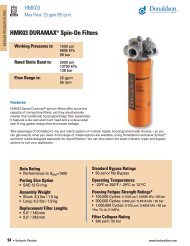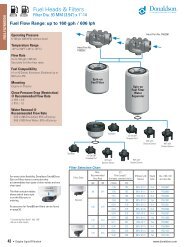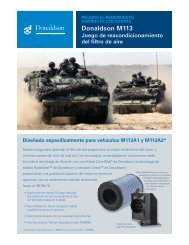Understanding Emulsified Water Filtration - Donaldson Company, Inc.
Understanding Emulsified Water Filtration - Donaldson Company, Inc.
Understanding Emulsified Water Filtration - Donaldson Company, Inc.
Create successful ePaper yourself
Turn your PDF publications into a flip-book with our unique Google optimized e-Paper software.
For emulsified water separation test, SAE J1488 is not really<br />
comparable with ISO 4020 because of the undefined water<br />
droplet size. ISO 4020 is typically used for low fuel flow tests,<br />
while SAE J1488 can be used for a maximal fuel flow rate up<br />
to 100 L/min. The key differentiating factors are the fuel pump<br />
applied and the test water concentration. For SAE J1488,<br />
centrifugal pump with strong mechanical shear (3500rpm) and<br />
0.25% water concentration are recommended, so the water<br />
droplet generated is supposed to be much finer and better<br />
dispersed in fuel. On the contrary, ISO 4020 recommends a<br />
low shear diaphragm pump with 2% water injection, so the<br />
droplet formed should be much larger and a significant droplet<br />
agglomeration is expected due to the higher water<br />
concentration. The implication of these differences is that the<br />
SAE J1488 can be a more stringent test standard as opposed to<br />
ISO 4020. As a result, a filter passing the ISO test may not<br />
pass the SAE test even when the water concentration of the<br />
ISO is 7 times higher. This has to do with the emulsion<br />
stability and the fuel flow rate which will be discussed in the<br />
next sections.<br />
The ISO/TS 16332 is targeted at tests using fuels with low IFT<br />
(15 mN/m). There are options for choosing the inject water<br />
concentration from 1500 ppm to 2%. The water droplet is<br />
generated through an orifice installed after the fuel pump, with<br />
a suggested median droplet size of 60 um. This has not become<br />
an ISO test standard yet, but it does shed some light on how<br />
the test should be conducted for the future diesel fuels<br />
including ULSD and biodiesel, whose surfactancy can be<br />
much higher. We believe that by lowering the IFT of SAE<br />
J1488 from 25-30 mN/m to below 15 mN/m can allow us to do<br />
a stricter test for emulsified water separation. However, we<br />
must measure the mean or median droplet size to confirm our<br />
hypothesis. We anticipate the size to be much smaller than 60<br />
um because of the strong mechanical shear generated by the<br />
centrifugal pump. We also expect the water-in-fuel emulsion<br />
formed in ULSD is more stable than in regular low sulfur<br />
diesel fuel due to the increased surfactancy effect. In addition,<br />
we have found fuels from different suppliers with the same<br />
IFT will respond to filters similarly because the fuel additive<br />
packages used are different. And finally, we believe filter<br />
configuration could have significant effect on emulsified water<br />
filtration efficiency by manipulating media face velocity and<br />
fuel flow dynamics.<br />
EMULSIFIED WATER DROPLET SIZE<br />
To quickly evaluate filter media, we built a flat sheet<br />
fuel/water test bench based on the understanding of SAE<br />
J1488. The bench applies a centrifugal pump; the emulsified<br />
water can be generated continuously for regular media tests<br />
and emulsion sizing. The flat sheet holder is shown in Fig.1.<br />
Depending on the media type, we can evaluate both a flatsheet<br />
barrier and a flatsheet coalescer. A laser diffraction particle<br />
size analyzer made by Beckman-Coulter was used to size the<br />
water-in-fuel emulsion generated from the bench. <strong>Water</strong><br />
concentration was measured by volumetric Karl-Fischer<br />
titration.<br />
Fig. 1 Flatsheet media holder for fuel/water separation<br />
Fig. 2 shows the water droplet size distribution in #2 diesel<br />
fuel with an IFT of 31 mN/m. The inset gives the mean and<br />
median size versus inject water concentration. The mean size<br />
of the emulsion ranges from 25 um to 35 um at the test<br />
conditions specified. For this fuel, water particles of 15-23<br />
um contribute 50% to the total volume of the emulsified<br />
water. The higher the feed water concentration, the larger the<br />
droplet size due to the agglomeration effect of the instable<br />
emulsions. Note that the median size of the emulsion is even<br />
smaller which ranges from 15 um to 32 um. With water<br />
concentration ranging from 1000 ppm to 5000 ppm, the<br />
droplet size is about a half to a quarter of the size suggested<br />
by ISO/TS 16332, while the IFT is twice as high. Based on<br />
this measurement, we can speculate that the median emulsion<br />
size undefined by ISO 4020 is even greater than 60 um. This<br />
further indicates SAE J1488 is a more stringent test standard<br />
if the fuel flow rate meets the requirement of ISO 4020,<br />
which is typically lower than the tests per SAE standard.<br />
40<br />
50<br />
35<br />
45<br />
30<br />
40<br />
25<br />
35<br />
20<br />
30<br />
15<br />
25<br />
10<br />
20<br />
0 2000 4000 6000<br />
Feed water conc, ppm<br />
Southwest Research 8 th International <strong>Filtration</strong> Conference<br />
Mean droplet size, um<br />
Median droplet size, um<br />
mean size<br />
median size<br />
Fig.2 <strong>Water</strong> droplet size distribution in original #2 diesel fuel<br />
2


